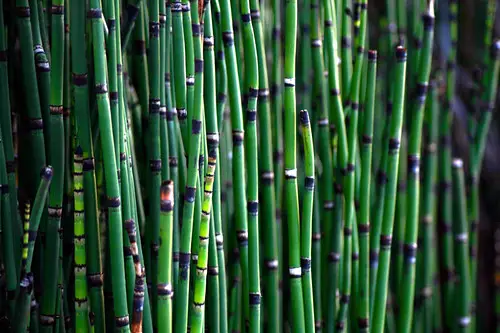Horsetail Plant, scientifically known as Equisetum, is one of the oldest plant species still surviving today, with a lineage that dates back over 300 million years. Resembling a horse’s tail, this perennial herb is instantly recognizable by its jointed stems and a brush-like appearance. It’s often found in moist, sandy soil near rivers, ponds, and roadsides.
The appearance and structure of the horsetail plant are unique, with hollow stems and a lack of true leaves or flowers. This ancient plant has had various uses over time, including medicinal applications, polishing tools, and as a supplement for horses. Though horsetail is admired for its architectural form and historical significance, it can be quite invasive in gardens, demanding careful control and management.
In terms of cultivation, horsetail requires specific care tailored to its unique characteristics. It thrives in wet, marshy conditions and can spread quickly if left unchecked. While it can be an attractive addition to water gardens or used for erosion control, the cultivation of horsetail does present challenges that gardeners should be aware of.
| Attribute | Details |
|---|---|
| Common Names | Horsetail, Scouring Rush, Mare’s Tail |
| Botanical Name | Equisetum spp. |
| Family | Equisetaceae |
| Plant Type | Perennial herb |
| Mature Size | 1 to 4 feet (0.3 to 1.2 meters) |
| Sun Exposure | Full sun to partial shade |
| Soil Type | Wet, sandy soil |
| Hardiness Zones | 3-11 |
| Native Area | Northern Hemisphere |
Horsetail Care
Horsetail is known for its preference for wet, swamp-like conditions, and it can often be found growing naturally in ditches or near bodies of water. To cultivate horsetail successfully, it’s essential to replicate these conditions by providing ample water and selecting an appropriate location. Planting horsetail in containers can help contain its invasive tendencies.
In terms of sun exposure, horsetail is quite adaptable and can grow in both full sun and partial shade. It’s generally low-maintenance but requires vigilance to prevent it from spreading uncontrollably. Pruning, barrier installation, or growing in pots can be effective ways to manage its growth.
Light Requirement for Horsetail
Horsetail grows well in full sun but can also thrive in partial shade. While it’s tolerant of various light conditions, providing ample sunlight can encourage robust growth.
Soil Requirements for Horsetail
Horsetail prefers moist, sandy soil that replicates its natural marshy habitat. Good drainage is essential, but the soil should remain consistently wet to satisfy the plant’s water-loving nature.
Water Requirements for Horsetail
As a water-loving plant, horsetail requires consistent moisture. It’s ideal for water gardens or areas where the soil remains constantly wet. Drying out can lead to the wilting of the plant, so regular watering is crucial.
Temperature and Humidity
Horsetail is adaptable to a range of temperatures and can grow in USDA hardiness zones 3 to 11. It appreciates high humidity, reflecting its natural habitat near water bodies.
Fertilizer
Horsetail generally does not require fertilization, as it can thrive in nutrient-poor soil. Over-fertilization can lead to excessive growth, making the plant even more invasive.
Pruning Horsetail
Regular pruning is essential to contain the spread of horsetail. Cutting back the stems can help maintain its size and prevent it from invading other parts of the garden.
Propagating Horsetail
Horsetail can be propagated through division or by planting spores. Care should be taken to control its spread, as it can become invasive quickly.
How To Grow Horsetail From Seed
Horsetail does not typically grow from seeds but rather reproduces through spores. These spores can be collected and planted, although this method of propagation is less common.
Common Pests & Plant Diseases
Pest and Disease-Free
Horsetail is generally free from common pests and diseases, one of the factors contributing to its robust nature.
Common Problems With Horsetail
Invasive Growth
Horsetail can quickly become invasive, taking over garden spaces. Planting in containers or using barriers can help contain its spread.
Pro Tips
- Consider planting horsetail in containers to control its spread.
- Utilize horsetail in water gardens or areas prone to erosion.
- Avoid planting near other plants that may be overwhelmed by its aggressive growth.
- Embrace horsetail’s architectural form in modern or minimalist garden designs.



